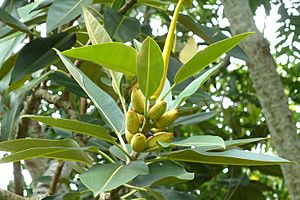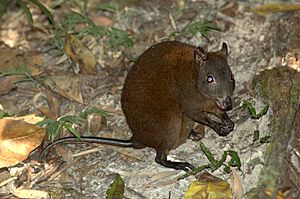Banana fig facts for kids
Quick facts for kids Banana fig |
|
|---|---|
 |
|
| Scientific classification | |
| Kingdom: | |
| (unranked): | |
| (unranked): | |
| (unranked): | |
| Order: | |
| Family: | |
| Genus: | |
| Species: |
F. pleurocarpa
|
| Binomial name | |
| Ficus pleurocarpa |
|
| Synonyms | |
|
Ficus cylindrica Warb. |
|
The Ficus pleurocarpa, also known as the banana fig, karpe fig, or gabi fig, is a special type of fig tree. It grows only in the wet tropical rainforests of northeastern Queensland, Australia. This fig is easy to spot because of its unique orange and red, ribbed, banana-shaped fruits.
The banana fig starts its life as a hemiepiphyte. This means it begins growing on another plant, often high up in a tree. Later, it grows its own roots down to the ground and can become a large tree, reaching up to 25 meters (about 82 feet) tall. What's really interesting about F. pleurocarpa is that it's one of the few figs pollinated by more than one type of fig wasp.
Contents
What is a Banana Fig?
Naming the Banana Fig
The banana fig, Ficus pleurocarpa, was first described by a German-Australian botanist named Ferdinand von Mueller in 1874. He wrote about it in his book Fragmenta Phytographiae Australiae.
The name pleurocarpa comes from ancient Greek words. Pleuro- means "ribbed," and -carpus means "fruit." So, pleurocarpa means "ribbed fruit." This name perfectly describes the fig's fruit, which has 5 to 10 ribs running along its length.
How Big Do Banana Figs Get?
Ficus pleurocarpa is a tree that can grow quite tall. It can reach heights of up to 25 meters (about 82 feet). Its leaves are usually between 150 and 257 millimeters (6 to 10 inches) long and 49 to 100 millimeters (2 to 4 inches) wide.
The fruits of the banana fig are called syconia. They are orange or red and are shaped like small bananas. They are typically 39 to 61 millimeters (1.5 to 2.4 inches) long and 19 to 27 millimeters (0.7 to 1 inch) wide.
How Banana Figs Reproduce
Figs and Wasps: A Special Partnership
Figs and fig wasps have a very close and important relationship. It's called mutualism, which means both the fig and the wasp benefit from each other. Figs can only be pollinated by fig wasps, and fig wasps can only reproduce inside fig flowers. Usually, each type of fig tree relies on just one specific species of wasp for pollination. The wasps also depend on their specific fig species to lay their eggs and grow.
What makes the banana fig special is that it's pollinated by two different species of fig wasps: Pleistodontes regalis and P. deuterus. This is quite rare, as most fig species only have one pollinator wasp.
Where Banana Figs Live
Ficus pleurocarpa is found only in Australia. Specifically, it grows in the wet tropical rainforests of north-east Queensland. You can find it from Cape Tribulation in the north down to the Atherton Tableland in the south. It grows in both lowlands and uplands, from sea level up to 1,000 meters (about 3,280 feet) above sea level.
Banana Figs in Nature

Figs are very important plants in their ecosystems. They are sometimes called keystone species. This means they play a critical role in keeping the ecosystem healthy. Figs often produce fruit at different times throughout the year, which makes them an important food source for fruit-eating animals when other foods are hard to find.
The banana fig is a great example of this. In some studies, it was found to be one of the biggest sources of fruit in the forest canopy, especially when other fruits were scarce. It was a very important food for fruit-eating animals. For example, during a time when food was low, F. pleurocarpa helped feed the musky rat-kangaroo population in one research area.
The fruits of the banana fig are relatively small and become soft when they are ripe. This makes them easy for many different fruit-eating animals to eat. Most of the fruits stay in the tree canopy, but some do fall to the forest floor, providing food for ground-dwelling animals.
Spectacled flying-foxes also eat the fruits of the banana fig. When they eat the fruit and then fly to other places, they help to spread the fig's seeds. This helps new banana fig trees grow in different areas.
Can You Eat Banana Figs?
Yes, the fruits of the banana fig are edible! You can eat them fresh when they are fully ripe and red. They are described as "tasty." You can also dry them to eat later.

